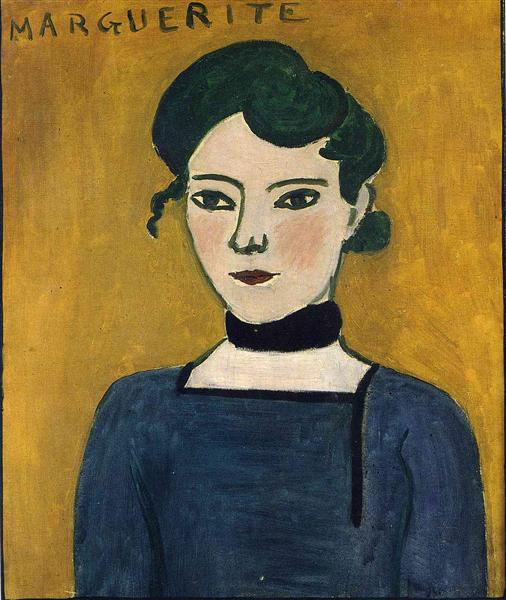Description
The painting "Marguerite" by Henri Matisse, created in 1907, is a work that clearly reflects the artist's mastery in the combination of color, form, and expression. In this portrait of his daughter Marguerite, Matisse achieves an amalgamation of elements that stand out both for their simplicity and their visual impact.
The first thing that catches the eye in "Marguerite" is the bold and vibrant color palette. Matisse, known for his Fauvist tendencies at this point in his career, employs saturated and contrasting colors. The predominant use of blue and green tones in the background grants an almost ethereal serenity to the portrait, making Marguerite, with her fair complexion and dark hair, stand out with an almost luminescent clarity. This chromatic contrast not only guides the viewer's gaze towards the subject's face but also conveys a sense of calm and introspection.
The composition of the painting is another aspect worth mentioning. Marguerite is depicted from the waist up, with her head slightly tilted and a soft, reflective expression on her face. Her eyes, a deep blue, seem to gaze beyond the physical space, immersed in thought. The simplicity of her clothing, a white blouse with a somewhat high collar, directs attention to her facial expression, which is the true protagonist of the work. The economy of detail in the clothing and the overall design reinforces the focus on Marguerite's feelings and personality.
Matisse employs in this work a technique of quick but careful brushstrokes, which allows him to combine flat areas of color with more meticulous details in the face and hair. This provides a rich texture that adds depth to the portrait without falling into the trap of hyperrealism. Instead of seeking a photographic reproduction, Matisse captures the essence and spirit of his daughter through expression and color.
It is important to consider this work in the context of Matisse's creative period. In 1907, the artist had already begun to distance himself from traditional impressionism and was exploring new forms of visual expression, which led him to become one of the pillars of the Fauvist movement. The distinctive elements that would be observed in his later work, such as the emphasis on powerfully emotional color and simplified forms, are fully present in "Marguerite".
The emotion that emanates from the portrait could also be interpreted as a reflection of the paternal relationship between the artist and his daughter. Within the Fauvist movement, which advocated a liberation of palette and form, Matisse found a way to express tenderness and emotional depth with great artistic freedom. This portrait not only functions as a visual representation of Marguerite but also as a testament to the intimate connection between father and daughter.
Thus, Matisse's "Marguerite", beyond its pictorial and aesthetic context, stands as a lasting testament to deep paternal affection and the tireless innovative spirit of the artist. It is a work that encapsulates both a personal quest and a stylistic revolution, a picturesque milestone where color and form unite in perfect harmony to tell an intimate and universal story at the same time.

